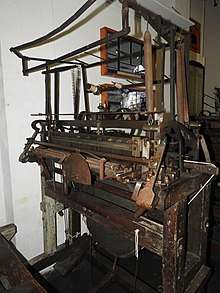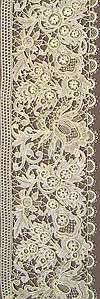Nottingham Industrial Museum

Nottingham Industrial Museum is situated in part of the 17th-century stables block of Wollaton Hall, located in a suburb of the city of Nottingham.[1] The museum won the Nottinghamshire Heritage Site of the Year Award 2012, a local accolade issued by Experience Nottinghamshire, an organisation funded variously by Nottingham City Council, Nottinghamshire County Council and other sources.[2]
The Museum collection closed in 2009 after Nottingham City Council withdrew funding, but has since reopened at weekends and bank holidays, helped by a £91,000 government grant. Now a volunteer-run organisation, the museum aims to be self-financing and charges for entry with higher fees at steaming events.[3][4]
The museum contains a display of local textiles machinery, transport, telecommunications, mining and engineering technology. There is a display of cycles, motorcycles, and motor cars. There are examples of significant lace-making machinery. It also houses an operational beam engine, from the Basford pumping station.
Context
Nottingham, Tiggua Cobaucc ─ Place of Caves, Snotengaham ─ "the homestead of Snot's people" was settled by the Vikings in 867 and by the Normans in 1086. They had established a castle there in 1067, which was fortified in stone 1120. Within the county, cloth was manufactured and dyed, and coal was taken from outcrops near the Derbyshire border. Alabaster was also an important mineral.[5] The city became the most important centre in the East Midands, being fought over in all the internecine royal squabbles from the Battle of Bosworth until the English Civil War. The castle fell into disuse and was dismantled in 1651. With the castle came all the supporting industries and commerce associated with a city. [6]
Collections
The museum divides the displays relating to five areas: Textiles, Transport, Communications, Mining and Steam.
Textiles

Two key inventions originating from Nottinghamshire gave rise to the local textile industry:
In 1589 local inventor, William Lee (inventor) of Calverton, developed a stocking frame knitting machine that enabled the manufacture of large volumes of stocking hoses. By the late 1700s hose production employed thousands of stockingers or framework knitters in and around Nottingham.[5]
In 1812, the Luddites smashed the mechanical frames believing this development was impoverishing the hand stockingers.
In 1808 John Heathcoat developed a hand operated machine which marked the beginning of the local lace industry though he later moved to Tiverton, Devon, after being forced out by the Luddites. [6]
The galleries here show stocking frames, a 1910 Warp knitting machine, a Wilman Circular, an Old Loughborough Bobbinet, a 1910 Heathcoat, a Leavers machine [lower-alpha 1] and a Barmen.
| Wikimedia Commons has media related to Knitting machines in the Nottingham Industrial Museum. |
There were over 130 lace factories in Nottingham's Lace Market area before changing fashions marked the decline of the industry.[7]
In 2018, one of the lace machines was returned to operational condition for the first time in over 50 years and can be seen operating on steaming days.
Transport
There is a small collection of with restored Raleigh bicycles and Brough Superior motorbikes (including George Brough's own trails motorcycle, made in Sheffield) Three thousand Brough Superior motorbike were made in George Brough's factory on Haydn Road, TE Lawrence was an enthusiast and was killed riding one of the eight he owned.[8]
The galleries display 17th-century Baskerville coach, the Brough superior car, a Celer car and Thomas Humber's own bicycle.[9]
]</ref>
-->
Mining and agriculture

Outside is displayed a large wooden Gin Wheel. This horse gin was removed from a colliery in Pinxton where it had been used for bringing coal to the surface up until 1950.[10]
In the gin yard is a coal truck from Clifton Colliery from the days when this mine was providing most of the coal for the nearby Wilford Power Station which was situated on the site of what is now the Riverside Retail Park.
Nearby is situated the recently restored living van. These were towed behind steam engines and steam rollers and provided accommodation for workers and their families whilst working on farms or road works. There are usually a number of tractors to be found in the tractor yard and these can be seen working during steaming days.[11] The tractor collection comprises a Standard Fordson and a Field Marshall Series 2.
Outside the engine house is a yard which is home to a number of barn engines, used previously to drive items like pumps and agricultural machinery. There are examples from manufacturers such as Wolseley. The barn engines are usually seen operating at steaming days.
Steam
The Steam Gallery contains an impressive Basford Beam Engine, one of a pair of engines built in 1858 by R. W. Hawthorn in Newcastle upon Tyne. It was installed at Basford Pumping Station to lift water 110 ft from the sandstone below to supply fresh water to the City of Nottingham. The engine was replaced in 1965 and was removed to the purpose-built Steam Gallery where it was first fired in 1975.
Also in this building today are a large variety of pumps and engines many of which were removed from local companies.
At the bottom end of the gallery stand two impressive ploughing engines. These have consecutive registration numbers and were the last two production engines to come out of Fowlers Leeds Foundry. Owned by Nottingham City Council, they were used for ploughing the treated sewage into the land at a large dairy farm at Stoke Bardolph. One of these engines is operational and is used at the steam up events.
Next to the ploughing engines is a unique J. T. Marshall Portable steam engine, built at the Nottingham Engineering Works, Sandiacre, in 1886. It has been restored to full working order and can be seen operating at the steam up events.
Other exhibits
An operational model railway can also be seen in the steam hall along with a working model of a Robey stationary engine. In a separate room there is a very large stationary mill engine that was previously housed in a Nottinghamshire pub before being rescued by the museum. Behind the mill engine lies a display of model stationary and railway engines.
Notes
- ↑ Invented by John Levers, the 'a' was added to aid pronunciation
References
- ↑ "Nottingham Industrial Museum".
- ↑ "2012 Nottinghamshire Heritage Awards".
- ↑ Nottingham Industrial Museum reopens after three years, BBC News, Nottingham, 17 March 2012. Retrieved 7 April 2017
- ↑ Nottingham Industrial Museum, events calendar 2017, Retrieved 7 April 2017
- 1 2 "Short history of Nottinghamshire". BBC. Retrieved 30 July 2017.
- 1 2 "History - The University of Nottingham". www.nottingham.ac.uk.
- ↑ "Nottingham Lace History - Experience Nottinghamshire". www.experiencenottinghamshire.com.
- ↑ Joseph, Anthony; Davies, Katie Louise (14 December 2015). "Rare Brough Superior motorcycles found in a barn". Mail Online. Retrieved 30 July 2017.
- ↑ Nottingham Industrial Museum - Collections
- ↑ Interpretative board on the site 2015.
- ↑ Nottingham Industrial Museum - Collections
External links
| Wikimedia Commons has media related to Nottingham Industrial Museum. |
Coordinates: 52°56′53″N 1°12′44″W / 52.948110°N 1.212220°W

